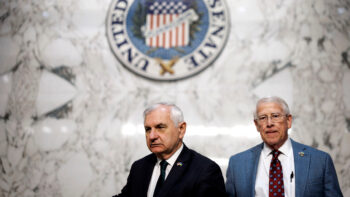
U.S. Sen. Todd Young (R-ID) references a chart on rising costs during a press conference on inflation, at the Russell Senate Office Building on February 16, 2022. (Kevin Dietsch/Getty Images)
With inflation soaring, Americans are starting to feel the pinch in everyday life. That could be even worse for members of the military, according to American Enterprise Institute budget experts John Ferrari and Elaine McCusker. In this new op-ed, they call for the Pentagon to avoid the usual games defense leaders play with inflation and give an honest accounting in the upcoming fiscal 2023 budget request.
On March 10th, the US Government released the inflation numbers for February: a shocking 7.9% in the largely tracked Consumer Price Index (CPI). What is even more harrowing is that this is not the worst to come; with war raging in Europe, it is likely that the CPI will top 8% for March.
Last year, the inflation anaconda was projected to squeeze Department of Defense readiness. At that time, many government leaders were wrongly referring to inflation as transitory, a term they have since ditched. In more recent comments, Mike McCord, the Comptroller for the Defense Department, has rightfully identified inflation as a concern within the defense budget, also rightly noting that the department has been playing catchup for two years on inflation before the recent CPI jump.
With global violence increasing stress on operational accounts, DoD cannot continue to lose ground. Playing catchup has historically been a code word for less readiness and less procurement spending. If compounded interest is the miracle of growth, then the seeds of destruction lie in compounded inflation. McCord also stated that the inflation impact to DoD is less than the now 7.9% CPI rate, noting that the department uses a bunch of different tools and calculations to determine its inflation impacts. As the FY23 budget is released in the coming weeks, we need to be on the lookout for two pesky ways inflation effects may initially remain hidden – passing the buck and rosy assumptions.
The most pernicious way of disguising the full impact of inflation is to pass the buck. For example, how will DoD portray the pay raise for military members and their families? If the pay raise is 4.7% as required by law for FY23, then DoD will be able to keep its personnel cost increase below inflation — by passing an over 3% real pay decrease onto the military. While this amount may be insignificant for those on the upper end of the pay table, it is potentially crushing to the lower ranking enlisted members with families. Couple this real pay cut with the expiration of the pandemic relief payments and end of the monthly child tax credit payments, and the cumulative effect could devastate the financial readiness of the force.
Another example of passing the buck is to buy fewer items. For example, if the price of a Joint Strike Fighter goes up by 10%, then DoD can just cut production by 10%, spending the same total dollars but getting less in return. This would be a DoD version of shrinkflation. When the FY23 budget is submitted, DoD should explain when the unit prices for major procurement items were set. As inflation moves through the supply chain, those unit prices will go up. If DoD is buying fewer items given the dollars it has, it will essentially be passing the buck to warfighting units who have to use older and less capable weapons and munitions because the department is buying fewer new ones.
The other way of hiding inflation is to use unrealistically optimistic assumptions about inflation. In this case, DoD is hostage to OMB, who sets the assumptions for the whole of government. These assumptions drive defense spending plans not just for the coming year, but into the future. Last year, as is common in the first year of a new administration, DoD did not release its five-year spending plan, known as the FYDP; this year, that future outlook should be included in the budget request, and inflation assumptions will drive those numbers.
There are a few places to look when the budget comes out for indications of how rosy the economic assumptions are.
The first is fuel prices. In current DoD budget materials, it is hard to decipher assumptions for fuel because they use an inflation number change from previous years, and they provide no high/low estimate on how the change in their assumption would affect readiness. With crude now over $100 per barrel (and rising), DoD owes the American public and Congress a clear understanding of how variability in fuel prices will impact how the military will be able to train, sail, and fly.
The second is future pay raises. If the pay raise assumptions beyond FY23 are below 4%, then that could be an indication that OMB plans to continue to lower the real wage of the fighting force. This will put into jeopardy the ability of our military, particularly the Army, to preserve our most important warfighting advantage – our young men and women.
The last thing to look for in the realm of rosy assumptions is in the category of other purchases. Last year’s budget, as shown in Chapter 5 of the DoD Greenbook, projected non-pay, fuel, and medical for 2022 to be 1.9% — a number McCord now acknowledges was too low. If we see numbers under 5% going forward, we should take that as a sign that again, the out-year projections are likely to be understated.
Again, OMB, not the Pentagon, sets those budget figures. However, DoD is accountable to our military members, our elected representatives, and to the American public to honestly explain the impact of these numbers. In its 2022 budget briefing, DoD claimed that its 2.7% pay raise was taking care of our people “with competitive pay and benefits.” In the face of a nearly 8% inflation rate, that is simply no longer the case. If 4.7% is the best we can do, then we just need to say so and then admit we may have recruiting and retention problems. The same goes for fuel, medical, and other costs.
In May 2021, the Secretary of Defense and the Chairman released a joint press release describing $715B in defense funding requested as sufficient. The services obviously did not believe it was sufficient as they provided billions in unfunded critical priorities, most of which were funded by the Congress.
Maybe this year defense leadership should just say they are doing the best with the money provided and highlight the challenges; if we are asking the military to accept more risk, then let us be honest with the American public about it.
Maj. Gen. John Ferrari, US Army (ret.), is a visiting fellow at the American Enterprise Institute (AEI) and is the former director of program analysis and evaluation for the US Army. Elaine McCusker is a senior fellow at the American Enterprise Institute (AEI) and a former Acting Under Secretary of Defense (Comptroller).






















